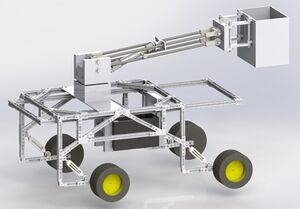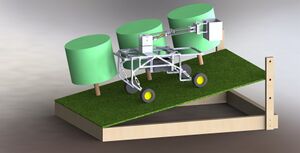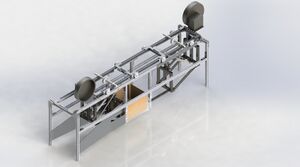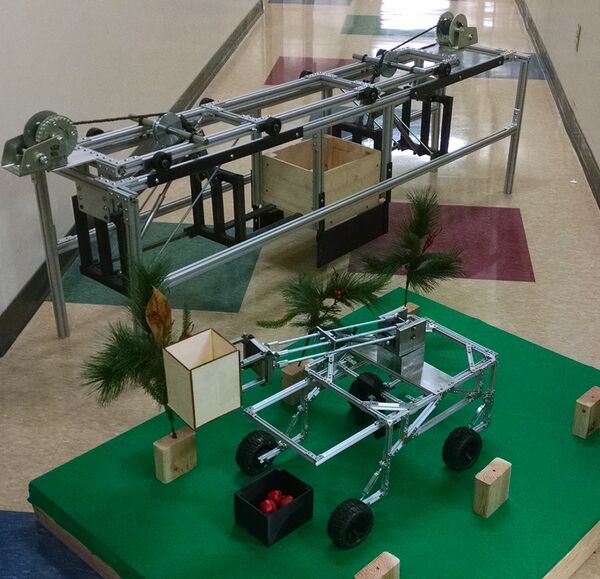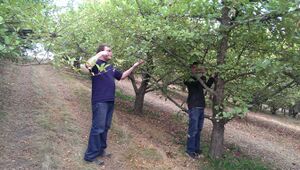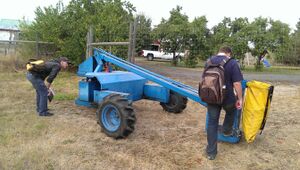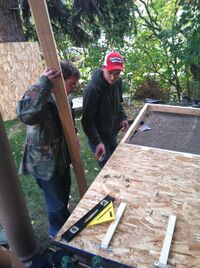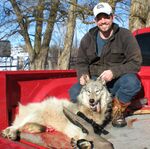Orchard Harvesting and Pruning Platform
| 1/10 Scale Model | |
| Client : | Joe Rumble - Owner of Rumble Orchards |
| Team Name : | Top Pick |
| Duration : | Fall 2014 - Spring 2015 |
| Faculty Advisors : | Dr. Steve Beyerlein |
| Mentor : | Sam Qualls |
| Group Members : | Vince Schwartz
Dillon Turnbull Zachary Howard Dhari Aldehani |
The goal of the finished project is to create a platform that will aid orchard workers in picking and pruning fruit bearing trees. In order to demonstrate this, we will create everything in 1/10 scale aside from the bin management system, which will be in 1/4 scale to better demonstrate the functionality.
Problem Definition
Problem Statement
The current system for picking and pruning fruit trees is labor intensive and physically demanding. Workers must be able to move, position, and climb ladders to reach fruit located up to 15 feet high and 3 feet inside of the outmost branches. The positioning and climbing of the ladder consumes much of the workers’ time and energy. Workers can be burdened by as much as 60 pounds of fruit while performing these tasks, which demands workers be physically fit. Bearing this weight while on the ladder also poses huge safety risks to the workers. Current machines do not allow the worker to pick fruit continuously.
Goal
The goal of the project is to design a platform that will increase the safety and efficiency of picking and pruning fruit bearing trees. To eliminate the use of the ladder, workers will operate a one-man platform. This platform will be capable of vertical movement, lateral movement, self-leveling, and fruit storage and transportation. The picker will be able to drive and safely pick on slopes up to 30% or about 17 degrees. The worker will be able to control all movements from the platform.
Background
Joe Rumble owns an orchard in Washington that has grades within the orchard of up to 30 degrees. He currently has each of the workers in the orchard pick the fruit by hand and place it in a bag hanging down the worker’s chest. The worker must move around with this bag and a ladder in order to navigate the trees in the orchard. This can be a dangerous endeavor because the bag can get up to 60 pounds before it is emptied into a bin. There are also time inefficiencies in this process because of the constant re-positioning of the ladder, and the worker emptying their bag every tree or less. This was not only time consuming, but physically demanding on each of the workers. The steep grades in the orchard prevent the current picking platforms to be a viable option. Although the picking will still have to be done by hand because of the delicacy of the fruit, a machine that will aid the workers in their picking, and eliminate the constant movement of an individual ladder is our goal. The current state of the picker working conditions has not been changed in nearly 100 years, and is need of a safer, more efficient option for sloped orchards.
In order to see an orchard and the equipment that was used, the group visited Bishop's Orchard in Garfield, Washington. Although this was not our client's orchard, the sense of the slopes through the orchard were similar. The only power equipment used by this orchard was a picker lift. This was a three-wheeled device that would raise and lower a picker so that the top branches could be reached. The type of bag that was used was the same as a picker climbing a ladder, so the bag had to be emptied manually. This platform was sturdy due to the three-wheeled design, but the maneuverability of the machine was limited because the entire machine would rotate to get the arm with the picker into the correct position. This was clumsily done, and could easily cause damage to the trees because of all the branches it could hit during its movement.
Deliverables
| General Requirement | Specific Requirement | Goal |
|---|---|---|
| Self-leveling | The platform will be able to self-level to accommodate a variety of slopes. | The model will use a micro-controller and small motors to achieve self-leveling. |
| Lateral Movement | The picker needs to be able to move laterally distances up to 3 feet into a tree from the outer edge. | The scaled model will be able to achieve at least 3.6 inches of lateral movement from the edge of the tree. |
| Vertical Movement | The fruit bearing trees can be up to 15 feet tall. A vertical boom range of 10 feet is desired to allow the picker to reach all fruit. | A 12 inch vertical is required by our model. |
| Slope Accommodation | Slopes vary throughout the orchard. Slopes of 20-30% are typical. The picker would expect to go directly up the slope in addition to side-hill. | The model will be able to accommodate a minimum of 30% slope. |
| Fruit Transport | The platform will have to be able to carry a full sized bin and a transportation system from the top of the boom down to the bin to ensure no bruising occurs. | Ability to carry and put down a bin. Transportation system from the end of the boom to the bin. |
Specifications
Morphological Chart
Chassis:
- Corner leveling:
- This system divides the leveling needs among all four wheels. Each wheel is attached to a corner of the frame using a lever and a hydraulic piston. Each wheel is then free to travel up and down independently in an arc and level the frame in any direction. This design is the one we are currently using, because it divides the force among four points, it is flexible, and it can accommodate our current bin management design.
- Isolated leveling:
- This design uses two separate systems to control the leveling. The first would level the frame and bin management system front-to-back, and the second would level the boom and power systems side-to-side on a plate mounted atop the frame.
- All-in-one leveling:
- The first design I came up with. This design uses a central universal joint at the center of a rigid frame which the wheels are attached to. Four hydraulic pistons on each would connect to an upper frame, and would be used to level it.
Bin Management:
- Linear Transition Tractor Fork
- The linear transition tractor for utilizes a tried and tested design much like conventional tractors. The two biggest differences are the smaller size and the movement of just the forks isolated from the machine. Two big draw backs are the size required to get the linear motion we need and the amount of parts required is going to make the assembly heavy.
- Swinging forks
- The linear transition tractor for utilizes a tried and tested design much like conventional tractors. The two biggest differences are the smaller size and the movement of just the forks isolated from the machine. Two big draw backs are the size required to get the linear motion we need and the amount of parts required is going to make the assembly heavy.
- Sliding claws
- In the first design arm B be should be up and arm A should be outside. So the bin management will basically work winch. In fact, arm B will be up and whenever the bin is in the right place arm B will moves down then A will moves from inside. The last step is to left the bin up by arm B. honestly, this is the weakest design and all the guys did not like it because the two arm goes up and the will force us to make holes so those arms could fit the upper roof.
Boom Design:
- Double Beam
- The double beam system will have the ability to rotate about the base of the boom, rotate using a wrist at the end of the boom, and raise and lower at the base of the boom. A rod(s) would attach to a leveling plate to ensure the bucket stays levels and different heights. A hydraulic ram will be used to raise and lower the boom. A bar will have to bridge the space of the two beams so the hydraulic ram can be located between the two beams. The double beam allows for many advantages compared to a single boom. The two smaller beams will result in a decreased bending stress, more material to resist torsion, and a larger platform for fruit transport. A downside of the two beams is the space increase and the added weight.
- Single Beam
- The single beam would have the ability to rotate about the base of the boom, rotate using a wrist at the end of the boom, and raise and lower at the base of the boom. A rod(s) would attach to a leveling plate to ensure the bucket stays levels and different heights. The beam would have to be thick to withstand bending stresses and torsion. This is a very viable option and can be seen on many systems that are achieving a similar set of movements.
- Telescopic Boom
- The telescopic boom would have the ability to rotate about the base of the boom, rotate using a wrist at the end of the boom, and raise and lower at the base of the boom. A telescopic boom has a lot of appeal because it allows for a large range with a fairly compact design. However, there are several issues that also arise from a telescopic boom. The self-leveling could not be accomplished the same way unless the rod also telescoped, but controlling this would require a separate telescopic system powered by hydraulics. The smallest member would have to be sturdy enough resist any bending stress or torsion experienced by the boom. With each beam fitting inside the next, it is easy to get a massive main beam very quickly. In addition to this, a fruit transport system from the bucket down to the bin would be very tricky in conjunction with a telescopic boom and the excess cable from the control system would need a reel-in feature or risk being snagged by the branches of the tree.
Lateral movement of platform:
- Hydraulic rotation at joint
- This option provides support and rotation in one system. The joint has bearing inside that allow for rotation using hydraulics. This system is compact and is implemented on man-lifts currently. This option is our choice because it is already being implemented for this purpose and is more compact than the other systems.
- Hydraulic ram
- The hydraulic ram would push on arms attaching the platform to the leveling plate. Extended would push the platform one direction and retracting would allow for movement in the opposite direction. There would be 4 arms to support the weight of the picker and platform. Large systems, like tractors, use systems like this to rotate buckets. This idea would work for rotation but is more bulky than desired.
- Cable rotation
- This system is similar to reins or turning on a sailboat. The winch will reel in line when it wishes to swing the platform one direction and will release to allow the other arm to swing. This could be achieved by wrapping the line in opposite directions on the same spool and separating them. There is a lot of possibility for error with this system and it is bulky.
Fruit Transport to bin:
- Conveyor System:
- The conveyor system would be used to transport the fruit from the platform down to the bin. The double beam boom system makes this very simple to do and the conveyor will sit between the two beams. The conveyor could have large/lipped cleats that would hold the apples safely even when the boom is at extreme angles.
- Chute System
- The chute system would function by giving the apples a smooth surface with guide rails to slide down. The chute takes advantage of gravity and doesn’t require any power systems to move the apples down. However, at exteme angles, the apples would slide fast and could bruise when they struck the bucket.
- Vacuum System
- The vacuum system is utilized by the WHOOSHH design. They use membranes and negative pressure to move the apples quickly inward. The systems works extremely well; however, it is extremely bulky and not practical for our system.
Existing Systems
Whoosh Innovations Fruit Harvesting:
Brownie (similar to Orchard Ape):
Our System
1:10 Scale Model:
The 1:10th scale model was constructed out of 10mm extruded aluminum, similar to 8020, from MicroRax. This allowed our design to be free of welding, reducing our overall cost and construction time. Custom joints were designed and were water-jetted by WSU to fit the rails at our desired angles. Turn buckles are used at each of the arm connections to simulate hydraulic rams. RC wheels are fixed to the arms to provide a realistic look and prevent movement on the slope. The boom is constructed of a variety of purchased parts, as well as some machined in house. As many parts as possible were 3D printed to reduce weight and time spent machining.
1:4 Scale Bin Management System:
The 1:4 scale model was constructed out of a variety of components. The frame was built out an extruded aluminum, 8020. The rest of the model was build out of steel. Pieces were machined and welded together by the team to form the forks. Two winches simulate our hydraulics in this model. The model is able to roll back and forth using plastic wheel. Plastic pieces act as guides on the frame, keeping the wheels and bin in the correct place.
Final Assembly:
| Part 1-3 |
|---|
Project Learning
| Taking Dimensions of Trees | Analyzing Existing Designs | Building an Adjustable Scaled Orchard |
|---|---|---|
The team visited a local orchard to gain insight on a typical orchard's layout. This included measuring the dimensions of trees, measuring the average slope, and evaluating the current methods of picking.
After visiting the orchard, the team decided that recreating a scaled orchard would be the best option to demonstrate their design's functionality. The team constructed the orchard using plywood, 2x4, and metal bracket and hinges. The orchard has three adjustable ranges: 10%,20%,and 30%.
Team Information
| Vince Schwartz | Hobbies & Interests: Hunting, fishing, and playing soccer
| |
| Mechanical Engineering Undergraduate | ||
| Hometown: Idaho Falls, Idaho | ||
| Email: schw6383@vandals.uidaho.edu | ||
| Dillon Turnbull | Hobbies & Interests: Hiking, Climbing, Camping and Shooting.
| |
| Mechanical Engineering Undergraduate | ||
| Hometown: Nampa, Idaho | ||
| Email: turn1113@vandals.uidaho.edu | ||
| Zachary Howard | Hobbies & Interests: Model building, writing, and camping
| |
| Mechanical Engineering Undergraduate | ||
| Hometown: Middleton, Idaho | ||
| Email: howa7892@vandals.uidaho.edu | ||
| Dhari Aldehani | Hobbies & Interests: Playing soccer, target shooting, and building and designing things
| |
| Mechanical Engineering Undergraduate | ||
| Hometown: Kuwait City, Kuwait | ||
| Email: alde7811@vandals.uidaho.edu |
Document Archive
File:EXPO Poster Template 2015 Updated.pdf
